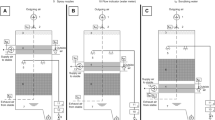Abstract
Agricultural production is a large consumer of thermal energy for various processes. Heat is necessary to maintain the microclimate on livestock farms in the cold season. Previous studies have reported that heat recovery of ventilation air can reduce thermal energy consumption by up to 40–60%. However, most of these studies were retrospective and descriptive in nature and they did not take into account the peculiarities of agricultural production technologies. The energy-saving method of microclimate support for livestock farms of a decentralized type is described. It is based on the principles of exhaust air heat recovery, ozonation and deep air recirculation. The article deals with the structural and technological schemes of the ventilation-heating device implementing this method. The main statements of calculation methods including the thermal-power, electrical and structural calculations are described. Polyethylene terephthalate film is used as heat exchange surface. The design constant of the heat exchanger is 180 W/°C. Exergy efficiency for the heat exchanger equal to 0.48 relative units. An expression was obtained to determine the convective heat transfer coefficient in the electric supply air heater. Corona discharge ozonator is used for purification and disinfection of circulating air. The experimental stand is used for automated registration, transfer, processing and storage of data. The results of experiments confirming the energy efficiency of the electrothermal installation are reflected on the charts. The implementation of the described method provides reduction of energy consumption up to 55%.





Similar content being viewed by others
References
Tikhomirov, D. A., & Tikhomirov, A. M. (2017). Improvement and modernization of systems and means of power supply is the most important direction of solving the problems of increasing the energy efficiency of agricultural production. Journal of Machinery and Equipment for Rural Areas, 11, 32–36.
Arkhiptsev, A. V., & Ignatkin, I. Yu. (2016). Automated system microclimate with heat recovery exhaust air. Herald NGIEI, 4(59), 5–14.
Panova, T. (2011). Development and validation of the parameters of supply and exhaust heat exchanger to improve microclimatic conditions in livestock buildings. Dissertation of candidate of technical Sciences: 05.20.01, Moscow.
Sventitsky, I., Alkhazova, E., Mudrik, V., & Obynochny, A. (2011). Energy saving by improving efficiency of using energy resources in agriculture and housing. Moscow: GNU VIESH.
Mishurov, N., & Kuzmina, T. (2004). Energy-saving equipment for microclimate in livestock buildings. Moscow: Rosinformagrotech.
Roulet, C. A., Heidt, F. D., Foradini, F., & Pibiri, M. C. (2001). Real heat recovery with air handling units. Energy and Buildings, 33, 495–502.
EI Foujh, Y., & Stabat, P. (2012). Adequacy of air-to-air heat recovery ventilation system applied in low energy buildings. Energy and Buildings, 54, 29–39.
Gubina, I. A., & Gorshkov, A. S. (2015). Energy saving in buildings with heat recovery exhaust air. Construction of Unique Buildings and Structures, 4(31), 209–219.
ASHRAE Handbook. (2008). Heating, ventilating, and air-conditioning systems and equipment (I-P Edition). Atlanta: American Society of Heating, Refrigerating and Air-Conditioning Engineers Inc.
Dieckmann, J. (2008). Improving humidity control with energy recovery. ASHRAE Journal, 50, 38–45.
Livchak, I., & Naumov, A. (2005). Ventilation of multi-storey residential buildings. Moscow: AVOK-PRESS.
Adamski, M. (2008). Longitudinal flow spiral recuperators in building ventilation systems. Energy and Buildings, 40, 1883–1888.
Adamski, M. (2010). Ventilation system with spiral recuperator. Energy and Buildings, 42, 674–677.
Mróz, T. M., & Dutka, A. (2014). Exergy–economic evaluation of heat recovery device in mechanical ventilation system. Energy and Buildings, 86, 296–304.
Kim, S.-M., & Lee, J.-H. (2012). Determining operation schedules of heat recovery ventilators for optimum energy savings in high-rise residential buildings. Energy and Buildings, 46, 3–13.
Dodooa, A., Gustavssona, L., & Sathre, R. (2011). Primary energy implications of ventilation heat recovery in residential buildings. Energy and Buildings, 43, 1566–1572.
Gendebien, S., Bertagnolio, S., & Lemort, V. (2013). Investigation on a ventilation heat recovery exchanger: Modeling and experimental validation in dry and partially wet conditions. Energy and Buildings, 62, 176–189.
Fernández-Seara, J., Diz, R., Uhía, F. J., Dopazo, A., & Ferro, J. M. (2011). Experimental analysis of an air-to-air heat recovery unit for balanced ventilation systems in residential buildings. Energy Conversion and Management, 52, 635–640.
Diskin, M. E. (2006). Efficiency of heat recovery in ventilation systems at outdoor temperatures below freezing hazard (p. 4). No: AVOC.
Kazancev, S. P., & Ignatkin, I. Y. (2013). Heat exchanger of the heat for a pig-breeding complex. Mechanization and Electrification of Agriculture, 4, 17–18.
The Company Gemmel. Equipment catalog: [website]. URL: http://Gemmel-lueftungstechnik.de. Accessed January 13, 2016.
Markelova, E., Petrov, L., Ukhanova, V., Tikhomirov, A., Tikhomirov, D., Pershin, A. (2013). Patent No. 2473213 of the Russian Federation, IPC A01К1/03. Method and device to clean air environment in livestock and poultry areas: GNU VIESH. No. 2011109389/13; Appl. 13.03.11; publ. 27.01.13, bull. no. 3.
Tikhomirov, D. (2013). Methodology of calculation heat and energy saving ventilation and heating installations for animal farms. Journal of Alternative Energy and Ecology, 2(1), 125–131.
Tikhomirov, D. (2013). Electrical and thermal calculation of air heater recuperative heat exchanger. Journal of Mechanization and Electrification of Agriculture, 1, 15–17.
Whitaker, S. (1972). Forced convection heat transfer correlation for flow in pipes, past flat plates, single cylinders, single spheres and in flow in packed beds and tube bundles. AIChE Journal, 18, 361.
Doctorov, A. (2003). Thermodynamics. A course of lectures. Novosibirsk: Novosibirsk state University.
Official website of the company “Production Association OWEN” [electronic resourse]. http://www.owen.ru/catalog. Accessed April 20, 2018.
Kruchinin, M., & Shadrina, E. (2007). Theoretical bases of energy and resource saving. Exergy analysis of heat exchangers. Ivanovo: GOU VPO Ivan. State Chemical-Technological University.
Author information
Authors and Affiliations
Corresponding author
Additional information
Publisher's Note
Springer Nature remains neutral with regard to jurisdictional claims in published maps and institutional affiliations.
Rights and permissions
About this article
Cite this article
Tikhomirov, D., Vasilyev, A.N., Budnikov, D. et al. Energy-saving automated system for microclimate in agricultural premises with utilization of ventilation air. Wireless Netw 26, 4921–4928 (2020). https://doi.org/10.1007/s11276-019-01946-3
Published:
Issue Date:
DOI: https://doi.org/10.1007/s11276-019-01946-3




